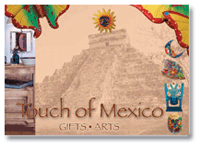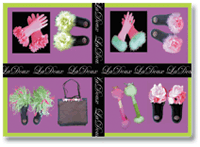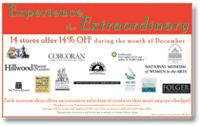Direct Impact: Five Steps to Creating a High-Impact Postcard Mailing
Five Steps
Postcards are fast, easy and inexpensive. For gift shop owners who want to get the word out and don’t want to waste time—or money—postcard mailings are a great way to draw traffic and generate sales.
Just follow these five steps to develop your own high-impact postcard program. You’ll be mailing in no time!
1. Create the list.
A customer mailing list is a goldmine, so if you don’t have one, now is the time to get started. The fastest, most efficient way to gather names for a customer list is at the cash register, where, (let’s face it), customers have a few moments of down time while their purchases are being rung up or their credit card is processing. We’re not talking a lot of time here, but there is enough time for a friendly employee to ask the customer if they would like to be sent a postcard when the store runs a special offer or has a sale.
Some gift shop owners make the sign-up process even more appealing by making it part of a customer-feedback form, or a contest entry form. They include a small box at the end of the form for the customer to check if they would like to receive a postcard mailing in the future (again, the customer is reminded that the postcard will announce special offers, or store sales).
 No matter what approach you use to gather customer information, the important thing is to, as Nike says, “Just do it.” Current customers are far more likely than others to buy from you. They are the customers most likely to become long-term repeat customers—the ones that will have the biggest impact on your bottom line. Developing a relationship with these customers through ongoing postcard mailings helps to keep your store in the front of their minds and reinforce the positive image they have of your shop. Just as surely, neglecting these customers will detract from your bottom line. And since there’s no line for “lost sales” on your profit-and-loss statement, you won’t even see the drag on your business’s potential.
No matter what approach you use to gather customer information, the important thing is to, as Nike says, “Just do it.” Current customers are far more likely than others to buy from you. They are the customers most likely to become long-term repeat customers—the ones that will have the biggest impact on your bottom line. Developing a relationship with these customers through ongoing postcard mailings helps to keep your store in the front of their minds and reinforce the positive image they have of your shop. Just as surely, neglecting these customers will detract from your bottom line. And since there’s no line for “lost sales” on your profit-and-loss statement, you won’t even see the drag on your business’s potential.
Here’s how to start and manage your customer list if you don’t have one already. If you’re using a POS system to process sales, chances are good the system has a customer-information module that will allow you to store names and mailing addresses and produce standard mailing labels. If you’re using a cash register, but have a computer for business operations, that system might have list-management capabilities, either as part of an email system address book, the word processing program, or another common program. Examples include Microsoft Works, Excel, QuickBooks Pro and Outlook. If you need to purchase separate database or list-management software, programs like MyMailList are available for less than $50 at many office supply superstores or online. If you are not inclined to start a customer mailing list, or if you simply want to supplement your customer list by mailing to non-customers, there are numerous sources for list rental in your area, such as community newspapers, local or regional magazines, and Chambers of Commerce.
If you aren’t comfortable renting lists on your own, you can find a list broker online or in the Yellow Pages (under mailing lists). List brokers will locate the list that fits your needs—for example, residents within a certain zip code, or those with a certain household income level—and will negotiate rental rates on your behalf. Brokers can help you find highly targeted lists—for example, new residents, grandparents, or antiques collectors—so you can zero in on the prospects most likely to become your best customers in the future.
2. Craft the offer.
 What offers do consumers really respond to? According to a 2005 direct-mail study conducted by Baltimore-based Vertis, Inc., consumers do have preferences when it comes to direct-mail offers. They are most likely to respond to the following offers, in order of preference: coupons, buy-one-get-one free, percentage-off, grand-opening invitations, and gift-with-purchase offers.
What offers do consumers really respond to? According to a 2005 direct-mail study conducted by Baltimore-based Vertis, Inc., consumers do have preferences when it comes to direct-mail offers. They are most likely to respond to the following offers, in order of preference: coupons, buy-one-get-one free, percentage-off, grand-opening invitations, and gift-with-purchase offers.
Think your best customers aren’t part of the coupon-clipping crowd? Think again. According to a 2005 Visa Signature poll of consumers defined as “New Affluents”—the seven percent of the population aged 35 to 54 with household incomes of at least $125,000—72 percent say they clip coupons, higher than the national average of 65 percent.
When it comes to wording the offer, gift shop owners only have seconds to capture the reader’s attention.
According to copywriter and direct mail expert Gary Halbert, most people sort their mail over a wastebasket, so the copy needs to be focused, clear and compelling.
Here are some ideas you can use to craft an offer that gets noticed:
- “Secret Sales” or “Pre-Sales” for “preferred customers only.” Reward your best customers with an exclusive “secret sale” or “pre-sale day” that’s only for preferred customers. Include a coupon, or percentage-off bonus.
- New Product Lines. If you are bringing in a special line of candles, adding a new pet-themed line, or incorporating any new element to your product mix, let your customers know! Contact the new line’s supplier and ask them to partner with you on the mailing, sharing costs in exchange for publicity of the vendor’s line. Often vendors will spend some of their own marketing dollars to help defray mailing or printing costs if they can boost their own brand’s visibility.
- Seasonal Sales. Build excitement by announcing a deal on new seasonal products or a deep discount on end-of-season merchandise.
- Special Days. When you know your customers are likely to be searching for “that special gift” for special days such as Mother’s Day or Valentine’s Day, mail a postcard in advance letting them know what gifts you are showcasing. If you are fortunate enough to gather a detailed customer list, you can even mail individual offers in advance of upcoming birthdays or an anniversary.
- Thank-You Notes. Don’t miss the opportunity to make an after-sale contact! Within 30 days of a purchase, send new or existing customers a thank-you note with a discount offer on their next purchase. Your customers will know that you appreciate their business, the mailing will keep your store top-of-mind, and the discount gives them one more reason to return to your store.
- Invitations. Grand openings, grand re-openings, and in-store demonstrations or special events create excitement, and let customers know that “there’s always something happening” at your store. Include a special coupon or bonus offer that gives shoppers a reason to attend—a reason to buy—beyond the enjoyment of the actual event.
Because a postcard is smaller than other types of direct mail such as brochures or letters, you don’t have to be an aspiring novelist to write compelling copy. But you do have to choose your words carefully. Studies show that using the words “you,” “free” and “new” dramatically boost response rates.
According to Richard Goldsmith, author of Direct Mail For Dummies, (IDG Books, 2002) and chairman of The Horah Group, a New York City-based direct marketing agency, “power words” that appeal to consumers of all kinds include: “secret,””good news,” “sale,” “save,” “exclusive,” “special” and “discover.”
Lastly, if you’re mailing to your current customers, don’t forget to show appreciation and make readers feel special by calling them “preferred” or “loyal” customers.
3. Design the Mailing.
 A visually interesting postcard will grab the reader’s attention and help convey the nature of the offer. Elements such as photos or illustrations, the typefaces used and the colors chosen, should all work together to convey a unified message. But don’t clutter the postcard or distract the reader with too many graphic elements, warns Neil Raphel, president of Raphel Marketing in St. Johnsbury, VT. Instead, the mailing should have a simple layout that’s easy to read and understand in just a few moments.
A visually interesting postcard will grab the reader’s attention and help convey the nature of the offer. Elements such as photos or illustrations, the typefaces used and the colors chosen, should all work together to convey a unified message. But don’t clutter the postcard or distract the reader with too many graphic elements, warns Neil Raphel, president of Raphel Marketing in St. Johnsbury, VT. Instead, the mailing should have a simple layout that’s easy to read and understand in just a few moments.
All of the elements should reflect the character of your business, says Raphel. For example, a caricature or illustration may be appropriate for a store that sells fun and whimsical products, but might not be right for a high-end retailer. He also suggests that typefaces and colors match the store’s logo, signage and other advertising materials to increase brand recognition, readership and response.
Of course, including the store logo, address, phone number and website address is a must. Just make sure these elements don’t overshadow the offer.
4. Print and Mail.
To create the actual postcard, there are several options. First, you can buy colorful, professionally designed pre-printed postcards for as little as five cents each, to which you can add your own copy using a word processing program or a free software program provided by the postcard company. (See “Postcard Resources” box.) You can print the postcards on your office printer and mail them first class for 24 cents each.
If you want to lower your mailing costs, a trip to the local post office (or online to usps.com) will get you everything you need to mail at the lower bulk rate of 20 to 23 cents per postcard, if you barcode your postcards by zip (the per-piece rate on non-barcoded postcards is actually higher than the first class mail rate!). To secure a bulk rate permit, you’ll have to pay a $160 application fee and a $160 annual fee.
Another printing option is to use an online postcard company, most of which provide templates online, into which you can insert your own text, professional photography, logos or other graphics. Or, you can choose a pre-designed postcard that fits your store’s image or helps convey the theme of an offer or event. For example, a postcard showing a glossy photo of a dozen roses and chocolates, can help “tell the story” of an upcoming Valentine’s Day sale.
The services of online postcard printers often extend to mailing, too. In many cases they can mail your postcards first class for less than it would cost to secure and use a US Postal Service bulk rate permit. You’ll also receive undeliverable mail notices and changes of address, which are important for keeping your list updated. The US Postal Service also offers start-to-finish postcard design, creation, printing and mailing services online, complete with postcard samples and templates. For details of their concept-to-mailing services, go online to usps.com. Chains like Kinko’s and the UPS Store offer similar services, and are also available online.
5. Track Responses.
 The average response rate for a retailer’s postcard mailing is three percent, according to the Direct Mail Association’s most recent studies. That means if you send out 2,000 postcards that generate 60 inquiries, you’re doing pretty well.
The average response rate for a retailer’s postcard mailing is three percent, according to the Direct Mail Association’s most recent studies. That means if you send out 2,000 postcards that generate 60 inquiries, you’re doing pretty well.
More important, however, is the dollar amount in sales that you generate through the mailing. If those 60 customers each spend $50 in your store, that’s $3,000 in sales you might not have had otherwise. Subtract the costs of the mailing and you’ll have a good handle on your return on investment. To maximize your return, try testing different lists, postcard designs and offers. Changing any one of these elements could dramatically improve your results.
Once you have kick-started your postcard marketing, don’t let it stall. Regular communication—such as monthly or quarterly mailings—is an effective and affordable way to keep your store at the top of your shoppers’ minds, build a long-term relationship, bring in new customers and generate sales. And that’s what being a successful gift shop owner is all about.























